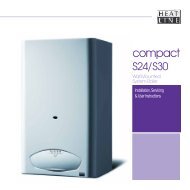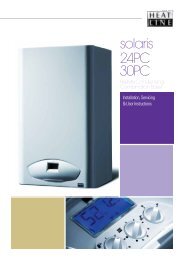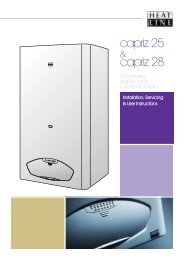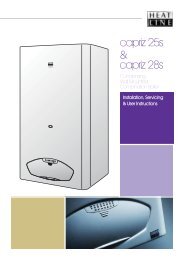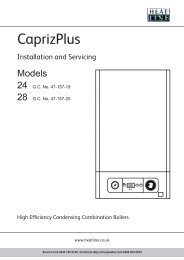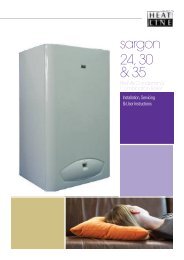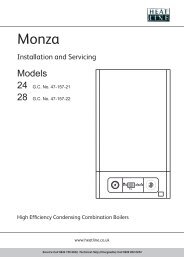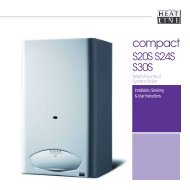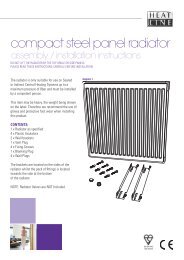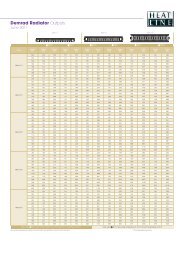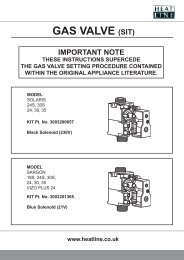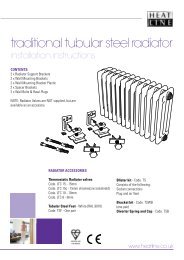Frozen Condensate Drains - Advice to Householders - Heatline
Frozen Condensate Drains - Advice to Householders - Heatline
Frozen Condensate Drains - Advice to Householders - Heatline
You also want an ePaper? Increase the reach of your titles
YUMPU automatically turns print PDFs into web optimized ePapers that Google loves.
Product Bulletin / Information<br />
Industry Initiative <strong>to</strong> reduce issues with <strong>Frozen</strong> <strong>Condensate</strong> <strong>Drains</strong><br />
outside temperatures have been below freezing for some time.<br />
the condensate drainage pipe runs through the wall and outside the property for<br />
part of its length, without any increased pipe diameter, any insulation on it, or other<br />
measures <strong>to</strong> prevent freezing. There may also be a problem if the pipe runs<br />
through an enclosed but unheated area, such as a garage or loft.<br />
the boiler has previously been working satisfac<strong>to</strong>rily.<br />
Shutdown due <strong>to</strong> freezing and blockage of the condensate drainage pipe will usually be<br />
indicated by a “fault code” on the boiler’s digital display, although this may not specifically<br />
indicate freezing as the fault. Indication may also be given by some other alarm such as a<br />
flashing light, or by a symp<strong>to</strong>m such as “gurgling” noises coming from the boiler.<br />
Note 2 - please refer <strong>to</strong> the boiler manual for guidance on fault codes/alarms and their<br />
meaning - the boiler manufacturer or the servicing company you use may also have a<br />
helpline or website giving guidance on this.<br />
2. Locate the blockage.<br />
It is likely that the pipe is frozen at the most exposed point external <strong>to</strong> the building or<br />
where there is some obstruction <strong>to</strong> flow. This could be at the open end of the pipe, at a<br />
bend or elbow, or where there is a dip in the pipe in which condensate can collect. The<br />
location of the blockage should be identified as closely as possible before taking further<br />
action.<br />
3. Thaw the frozen pipe.<br />
The pipe can be thawed by applying a hot water bottle, a microwaveable heating pack<br />
(the sort used for muscular aches and pains) or cloths soaked in warm water <strong>to</strong> the<br />
exterior of the pipe, close <strong>to</strong> the likely point of blockage. Warm water can also be poured<br />
on<strong>to</strong> the pipe from a watering can or similar container. Do not use boiling water.<br />
Note 3: You should not attempt <strong>to</strong> thaw a condensate drain pipe if you cannot easily reach<br />
it from ground level. Be aware that any water used can quickly freeze if it falls on<strong>to</strong><br />
pathways - causing a possible slip hazard.<br />
4. Reset/re-start the boiler.<br />
Once the blockage has been thawed and cleared, consult the boiler operating instructions<br />
or check the manufacturer’s website for guidance on any action needed <strong>to</strong> “reset” the fault<br />
code/alarm and re-start the boiler.<br />
In most cases, once the condensate drain pipe is cleared and a reset has been carried<br />
out, the boiler will re-ignite using an au<strong>to</strong>matic operating sequence.<br />
If this reset/restart does not succeed you should call in a competent engineer <strong>to</strong> assess<br />
the situation and take further action if required. Registered gas engineers in your area can<br />
be found using the postcode search facility on the Gas Safe Register website at<br />
www.gassaferegister.co.uk



